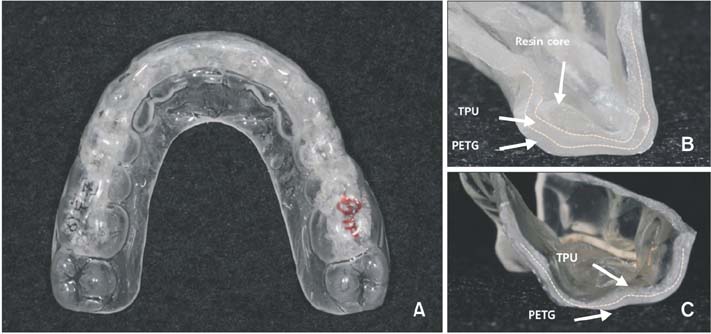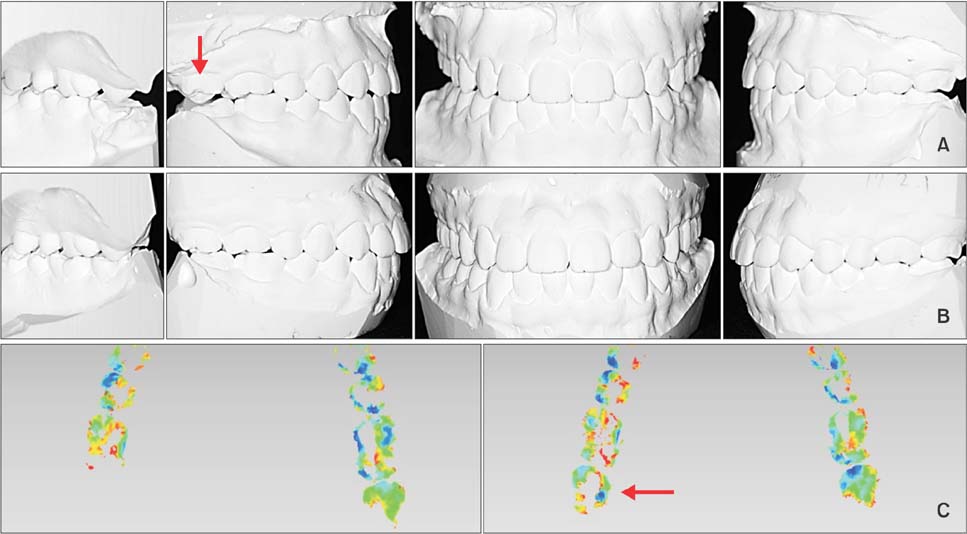Korean J Orthod.
2017 May;47(3):207-212. 10.4041/kjod.2017.47.3.207.
Effects of a new type of clear overlay retainer on occlusal contacts
- Affiliations
-
- 1Department of Orthodontics, Graduate School, Kyung Hee University, Seoul, Korea. bravortho@gmail.com
- 2Division of Orthodontics, Department of Orofacial Science, University of California San Francisco, CA, USA.
- KMID: 2379654
- DOI: http://doi.org/10.4041/kjod.2017.47.3.207
Abstract
- The popularity of clear overlay retainers (CORs) has increased recently because of their advantages such as better esthetics, cost effectiveness, easy fabrication, and good compliance. However, a deficiency in posterior occlusal settling is a reported limitation of CORs. The aim of this study was to evaluate the posterior occlusal contact changes in a new type of clear orthodontic retainer called Oral-treaper (OTP), which consists of three layers and has stronger mechanical characteristics than do conventional retainers. Three patients who completed fixed orthodontic treatment received OTP as a removable retainer. Cast models were fabricated after the removal of fixed appliances (T1) and after 4 to 11 months of using the retainers (T2). We evaluated all the cast models to compare the post-orthodontic settling pattern during the use of the OTPs. The depth of occlusal contacts was evaluated using color maps. The OTP did not prevent vertical settling in all patients but resulted in an improvement in posterior occlusal contact points.
Keyword
Figure
Reference
-
1. Keim RG, Gottlieb EL, Nelson AH, Vogels DS 3rd. 2008 JCO study of orthodontic diagnosis and treatment procedures, part 1: results and trends. J Clin Orthod. 2008; 42:625–640.2. Pratt MC, Kluemper GT, Hartsfield JK Jr, Fardo D, Nash DA. Evaluation of retention protocols among members of the American Association of Orthodontists in the United States. Am J Orthod Dentofacial Orthop. 2011; 140:520–526.
Article3. Rowland H, Hichens L, Williams A, Hills D, Killingback N, Ewings P, et al. The effectiveness of Hawley and vacuum-formed retainers: a single-center randomized controlled trial. Am J Orthod Dentofacial Orthop. 2007; 132:730–737.
Article4. Demir A, Babacan H, Nalcacı R, Topcuoglu T. Comparison of retention characteristics of Essix and Hawley retainers. Korean J Orthod. 2012; 42:255–262.
Article5. Sauget E, Covell DA Jr, Boero RP, Lieber WS. Comparison of occlusal contacts with use of Hawley and clear overlay retainers. Angle Orthod. 1997; 67:223–230.6. Dinçer M, Isik Aslan B. Effects of thermoplastic retainers on occlusal contacts. Eur J Orthod. 2010; 32:6–10.
Article7. Aslan BI, Dinçer M, Salmanli O, Qasem MA. Comparison of the effects of modified and full-coverage thermoplastic retainers on occlusal contacts. Orthodontics (Chic.). 2013; 14:e198–e208.8. Ahn HW, Kim KA, Kim SH. A new type of clear orthodontic retainer incorporating multi-layer hybrid materials. Korean J Orthod. 2015; 45:268–272.
Article9. Mai W, He J, Meng H, Jiang Y, Huang C, Li M, et al. Comparison of vacuum-formed and Hawley retainers: a systematic review. Am J Orthod Dentofacial Orthop. 2014; 145:720–727.
Article10. Thickett E, Power S. A randomized clinical trial of thermoplastic retainer wear. Eur J Orthod. 2010; 32:1–5.
Article11. Gill DS, Naini FB, Jones A, Tredwin CJ. Part-time versus full-time retainer wear following fixed appliance therapy: a randomized prospective controlled trial. World J Orthod. 2007; 8:300–306.
- Full Text Links
- Actions
-
Cited
- CITED
-
- Close
- Share
- Similar articles
-
- An occlusal contact analysis of lateral mandibular movement using T-Scan system
- Occlusal analysis using T-scan system after open reduction of mandibular fracture patients
- A correlation between bruxism and eccentric occlusal interferences
- A new type of clear orthodontic retainer incorporating multi-layer hybrid materials
- Comparison of two computerized occlusal analysis systems for indicating occlusal contacts





